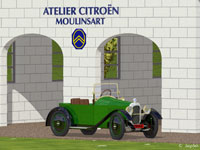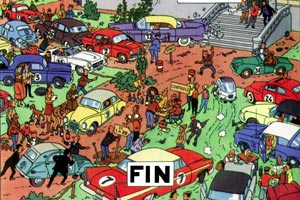


| The first three from "Tintin in the land of the Soviets" | |||||
 Mercedes ~ 1925 |

|
 Amilcar |

|
 Amilcar |
This first album contains a few less characteristic vehicles. |
| The next two cars from Tintin in America | |||||
 International or Ford 1930? or Citroën? |
  
|
 Bugatti |

|
The other cars of this albums are inspired by real cars, but Hergé did not care to draw exact reproductions. | |
| The most famous Ford Model T from Tintin in the Congo | |||||
 Ford Model T |

|
||||
| Three vehicles from The Blue Lotus | |||||
 Oldsmobile or Bugatti |
  |
 Armoured car |

|  Renault or Chrysler |
  |
| From Cigars of the Pharaoh | |||||
 Lincoln phaeton |

|
 A Bugatti or Amilcar racing car? |
 
|
 ...or Alfa Romeo? |
 
|
| This racing car is a clever hybrid of Bugatti, Alfa Romeo and Amilcar.
Hergé took later on great care of reproducing the cars in their minute details, so that a fragment of the grille or a wing are enough to identify the vehicle. This kind of perfectionism was fully implemented around 1936, beginning with the Broken Ear. In previous albums, many cars are approximations whilst later, there is almost no doubt to identify them. |
|||||
| The next three from The Broken Ear | |||||
 Hotchkiss ~ 1912 |

|
 1936 Ford |

|
 1934 Morris |

|
| Two tow trucks | |||||
 Tow truck from Black Gold |

|
 Tow truck from The Crab |

|
||
| The next nine from The Black Island (Attention: there are two versions of this album*) | |||||
 1936 Humber Pullman |

|
 1935 Vauxhall |

|
 Austin (?) |

|
 Jaguar Mark X |

|
 Triumph Herald |

|
 Ford Zephyr |

|
 Hanomag |

|
 MG 1100 |

|
 Dennis |
 |
| * See Variations | |||||
| King Ottokar's Sceptre | |||||
 1938 Opel Olympia See the other Opel below |

|
 1937 Ford V8 2 door convertible |

|
 The same Ford V8 here as a phaeton |

|
 1934 LaSalle |

|
 1932 Chevrolet |

|
 Gillet 1931 |

|
| The 1938 Packard coupé of King Muskar of Syldavia and two more Ford V8 | |||||
 1938 Packard |


|
 Another 1937 Ford as a 2 door sedan |

|
 The same Ford from The Seven Crystal Balls |

|
| Four versions of this 1937 Ford are shown in this page. There is a fifth example in the original version of the "Black gold" published in French in the Petit Vingtième (see also: "all cars"). It must have been a truly popular car in Belgium for Hergé to have used and re-used it... An explanation: Hergé worked together with the Belgian "Revue Ford" between 1937 and 1939. | |||||
| The Crab with the Golden Claws | |||||
 Renault NN |
 
|
 Amilcar Compound or Tatra |
 
|
||
| The Shooting Star | |||||
 ? ? ? |


|
There is only one car in this album, but I couldn't find the model: neither the Hotchkiss nor the Ford match Hergé's drawing: The Hotchkiss has doors opening the other way, and the Ford has a two-part windscreen and no wing lights. | |||
| The following five from The Seven Crystal Balls | |||||
 1938 Lincoln |

|
 1938 Opel |

|
 1939 Fiat or Simca |
 
|
 1936 Buick |

|
 1937 Ford V8 taxi cab |

|
||
| The next seven from Land of Black Gold | |||||
 Citroën 5 HP |

|
 1948 Ford |

|  1939 Ford |
 |
 My virtual version (POV) |
 Lancia "Aprilia" |

|
 1949 Buick "Eight" |

|
|
 1948 Morris Six See variations |

|

Jeep Willys |

|
||
| The Jeep, the two American cars and the fire truck of Destination Moon and Explorers on the Moon | |||||
 Jeep Willys |

|
 Dodge 1949 |

|
 Ford 1949 |

|
 Bedford |

|
||||
| The Calculus Affair — This album has the most cars of all | |||||
 3 in one pict |

|
 Citroën 15/Six |

|
 1954 Simca Aronde |

|
 The 2 CV of |
 Thomson/Thompson |
 Lancia "Aurelia" B20 |

|
 Mercedes 300 |

|
 > >My virtual version (POV) |
|||||
 Willys Station Wagon |

|
 Peugeot 203 |

|
 1953 Opel Rekord |

|
 1955 Chrysler |
  |
 Peugeot 202 |
 |
 Rover 75 1954 |
 |
 Saurer coach |
 |
 Bordurian convertible |
 |
All the cars in Borduria sport the famous moustache of Plekszy-Gladz. | |
| From The Red Sea Sharks | |||||
 Panhard |

|  Armoured car |
 |
 17 cars! |
|
| The next three from The Castafiore Emerald | |||||
 Alfa Romeo Giulietta |

|
 Citroën Ami 6 |

|
 Peugeot 403 |
  From my photo album. |
| From Tintin in Tibet | |||||
 1938 Cadillac |

|
||||
| From Tintin and the Picaros | |||||
 Mercedes or Zil inspiration |
 
|
 Land Rover 109 |

|
 Chevrolet 1951 |

|
 Jonckheere coach |

|
||||
|
More on variations, sundries, and the complete list of 216 vehicles. The last page contains all cars together with a picture of the original vehicle that inspired Hergé. Separately, I also compiled advertisements that Hergé made for Citroën with characters from the Tintin albums.
It should be noted that after World War II, the settings and accessories, including cars of Tintin albums were drawn by the "Studios Hergé", which included several other artists such as Jacques Martin, Bob de Moor and Michel Demarets. |
|||||
| If you don't agree with the information and data on this page, don't hesitate to send me your comments. If you have a better picture of the original cars, I would be grateful to incroporate them in these pages.
All pictures are obviously © Hergé, but this page was prepared by François de Dardel, who keeps the copyright of this study. You can imagine I needed hundreds of hours to research and identify all the cars. I was content only when I had found the perfect match in form of a photograph of the real car. This is not a commercial site: I have nothing to sell. It is only a study I made for my own enjoyment — and hopefully for the pleasure of some of my readers. I started these pages in March 2003. The following year, in 2004, the Éditions Moulinsart published a book on the same subject: "Tintin, Hergé, les autos", with additional information on some of the cars, adorned with a few typos and a commercial promotion for the miniature cars distributed by Atlas. Many viewers of these pages have helped me correct mistakes and identify some of the cars. My sincere thanks to all. Alphabetically: Mark Ashbridge, Iñaki Azpiazu, Eric Banzinger, Luc Balleyguier, Alfonso Barrola, Joris Bergsma, Alain Bingen, Frans van Bree, Michel Casaubon, Jean-Luc Coudray, Thierry Dubois, Jean-Marc Durieux, Thierry Federspiel, Daniel González, Claude Goritte, Marcus Hoogveld, Nick Knoll, Timo Laitinen, Jean-Noël Lamothe, Guillaume Lavie, André Martin, Ingo Menker, Thierry Milan, Pascal Monnin, Franck Noyalet, Yann Saunders, Guillaume Villemagne and Livio Zanone.
In november, 2011, The New York Times published an article about Tintin and his cars, referring to the present page. Hergé, born Georges Remi on 22 May 1907 in Etterbeek (Belgium), died on 3 March 1983 in Woluwe-Saint-Lambert. Updated on 22 December 2021 François de Dardel
|
|||||